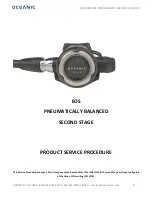
Operation
Altimeter Product Manual
0286-SOM-00001, Issue: 09
26
© Tritech International Ltd.
Industry Standard Output Strings
NMEA HDT
$--HDT,x.x,T*hh<CR><LF>
NMEA TRO
$--TRO,x.xx,a,y.yy,b*kk<CR><LF>
NMEA TRH
$--TRH,x.xx,a,y.yy,b,z.zz,c*kk<CR><LF>
PASHR
$PASHR,hhmmss.sss,HHH.HH,T,±RRR.RR,±PPP.PP,,rr.rrr,pp.ppp,hh.hhh,x,x*kk
<CR><LF>
TSS1
XXAAAASMHHHHQMRRRRSMPPPP<CR><LF>
TSS2
XXAAAASMHHHHQ MRRRRSMPPPP<CR><LF>
4.3. Seanet Pro & SeaKing or Super SeaPrince DST AUX Port
General Guidelines
It is possible to configure the AUX port on a SeaKing or Super SeaPrince DST sonar for
input of RS232 or RS485 serial data from a free running altimeter. The altimeter is connected
via a dual 6-pin Tritech interconnect cable which has a one-to-one wiring between the pins.
The DC power input of the sonar is linked through to the AUX port for the 24V DC supply
to the altimeter.
Caution
The supply to the SeaKing head SHOULD NOT exceed 28V DC, doing so will
damage the altimeter connected to the AUX port.
Caution
If using an altimeter with the RS232 board fitted it will be necessary to modify the
SeaKing head to enable communication. Details for this procedure can be found
Jumper Settings for SeaKing with Altimeter on AUX Port
. For this
reason it is recommended that an altimeter is chosen with the RS485 board fitted
because this avoids breaking the power isolation in the SeaKing head and also
allows the altimeter analogue output to be passed through the sonar head (via
a jumper setting within the SeaKing and on Pin 5).
Note
The altimeter will have to be in a compatible free running mode in order to work.
If it is set up for interrogated mode the switch settings will have to be changed
















































